|
Looking back
Ancient civilizations
The great Babylonian Empire
Last week, we travelled
back in time to bring you some interesting facts about Sumer, where
civilization 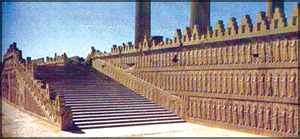 began... Today too, you can join us in our time capsule to make a
journey into yet another glorious era - the Babylonian period, which has
not only made a great impact on the Ancient World, but also present day
civilization.
began... Today too, you can join us in our time capsule to make a
journey into yet another glorious era - the Babylonian period, which has
not only made a great impact on the Ancient World, but also present day
civilization.
Babylonia, the capital of which was Babylon, was a state south of
Mesopotamia (modern Iraq) combining the territories of Sumer and Akkad.
The earliest mention of the City of Babylon can be found in a tablet
dating back to the 23rd century BC.
The Babylonian Empire which contained many Sumerian elements, endured
from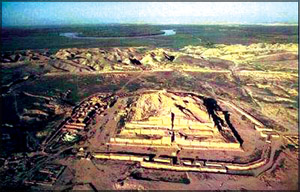 the 18th century BC to the 6th Century BC. Mesopotamia was not unified
under one king during the Sumer reign. However, some Amorites eventually
formed a monarchial government in the city state of Babylon and
ultimately took over the Amorite Kingdom to form the Babylonian Empire.
the 18th century BC to the 6th Century BC. Mesopotamia was not unified
under one king during the Sumer reign. However, some Amorites eventually
formed a monarchial government in the city state of Babylon and
ultimately took over the Amorite Kingdom to form the Babylonian Empire.
|
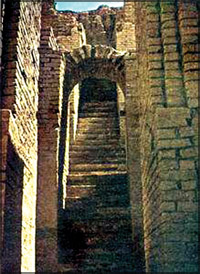
Ruins of Babylonia now located in Iraq
|
The three centuries they ruled is known as the Old Babylonian Period.
Babylon which means 'Gate of God' is one of the most important cities of
the ancient world. Today its location is marked by a broad area of
ruins, east of the Euphrates River, 90 km south of Bagdad, Iraq.
The highly urbanized civilization of Babylonia was based on
agriculture rather
|
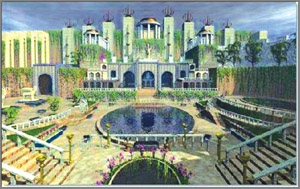
An artist’s impression of the Hanging Gardens of Babylon
|
than industry, and contained a dozen or so cities ruled by a
monarch.
The 120 year system of governance of this cradle of civilization was
so impressive that even neighbouring countries such as Assyria were
influenced by it. Let's check out how this great civilization
flourished....
How it was ruled
The dozen cities, surrounded by about 64 villages and hamlets, was
ruled by a monarch who appointed governors and administrators to work
for him. Each city had a mayor and council of city elders in charge of
local administration.
|
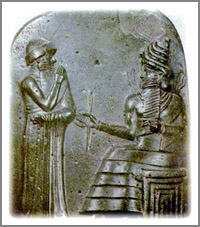
An image of the Sun god Samash handing over the laws to Hammurabi
|
The city of Babylon which rose to power in 1900 BC, increased its
power in the 1700s BC (1792-1750 or so) under the reign of general,
Hammurabi the Great, who became the monarch.
Even though its strength was reduced in 1595, the city grew into
greatness once more under Nebuchadnezzar II, thousand years later and
continued to dominate the region until Babylon fell to Persian rule in
539 BC.
The Babylonian army was well trained and had good leaders. Both
Hammurabi the Great and Nebuchadnezzar II waged war against surrounding
lands. Nebuchadnezzar was helped greatly by skilled archers to conquer
lands such as Phoenicia, Syria, Judah and Assyria.
The people of today have gained much information about the successful
mode
|

Jewellery used by Babylonians
|
of governance in this great Babylonian Empire from various
ancient documents and records discovered during archaeological
excavations. According to records, Babylonia was highly developed in
religion, history and science including medicine, chemistry, zoology,
maths and astronomy.
The Code of Hammurabi
One of the greatest discoveries made is the Code of Hammurabi
unearthed by French archaeologists J. de Morgan and V. Schell in Susa,
Iraq during 1901-1902.
The copy of the code containing 282 laws in all, is engraved on a
block of black diorite which is nearly eight feet in height.
|
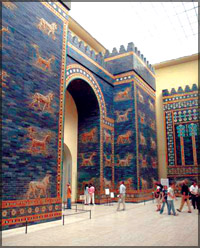
The famous Ishtar Gate
|
It is in cuneiform writing, comprising 16 horizontal columns of texts
on the obverse side (the side with the principal design) and 28 on the
reverse. It is presently housed at the Louvre, in Paris.
Hammurabi's code of laws affected all aspects of life such as trade,
farming, war and working conditions. It was introduced mainly "to cause
justice to prevail in the land, to destroy the wicked and evil, to
prevent the strong from oppressing the weak, and to further the welfare
of the people." Perhaps the Code of Hammurabi is ideal for the modern
world, where laws simply don't seem to exist.
Who made Babylon rich?
Son of Naboplashar (625-605 BC) Nebuchadnezzar II who reigned from
604-562 BC is credited for making the city of Babylon one of the richest
in the world.
|
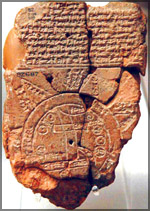
A world map in clay
|
The main entrance to the city, the now famous Ishtar Gate,
covered with glazed blue tiles was built during his time. Do you know
that the Hanging Gardens of Babylon, one of the Seven Wonders of the
'Ancient World' was his creation? He is said to have brought plants and
trees all the way from Persia to beautify the gardens.
Social life and religion
The Babylonian society comprised three classes known as awilu, a free
person of the upper class, the wardu or slave and the mushkenu, a free
person of low estate. The family was the basic unit of societies. Law
and justice were key concepts in the Babylonian way of life. Justice was
administered by courts, each of which consisted of one to four judges.
Once a decision was given, the judges couldn't reverse their verdict for
any reason. But, appeals could be made to the Emperor King.
The Babylonians worshipped many gods and Ishtar, the mother goddess,
and Marduk, the dragon god were considered to be the most powerful. It
is believed that even the laws in the Code of Hammurabi were given by
divine power. In fact, the code depicts an image of the Sun god Samash
handing over the laws to Hammurabi.
|
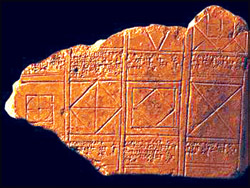
A clay slab used for mathematical purposes
|
Babylonians also believed that winged gods or genies protected the
palaces of the royals from demons and diseases.
There are many legends and myths about these gods and also Babylonian
heroes such as King Gilgamesh.
Don't you think the Babylonians were a great people who paved the way
for many useful things we enjoy in life today? Find out more about the
cradle of civilization - the Babylonian Empire, the ruins of which now
lie in modern day Iraq.
****
Fact file
* The Babylonians developed astronomy and knew the position of the
stars, planets, Moon and the Sun. They could also calculate dates and
the beginning of the seasons.
* They used two kinds of medicines - practical and magical remedies
for many recognised diseases.
* The Babylonians divided the day into 24 hours each, the hours into
60 minutes and minutes into 60 seconds.
* They developed an abstract form of writing based on the Sumerian
cuneiform writing symbols. These symbols were written on wet clay
tablets which were baked in the hot sun. Many of these tablets have
survived to this day.
* Even though they inherited the technical achievements of the
Sumerians in irrigation and agriculture, considerable knowledge and
skill was required in engineering to maintain the numerous dikes,
reservoirs and canals built by the Sumerians. They used leveling
instruments and measuring rods in the preparation of maps and surveys.
* Babylonian literature was well developed in the 3rd millennium BC
* During the reigns of Hammurabi the Great and his son Samsu-iluna
the Babylonian civilization reached the peak of its cultural development
and political power.
* Babylonians adopted the Sumerian system of formal education. The
curriculum consisted primarily of copying and memorising both textbooks
and Sumero-Babylonian dictionaries containing long lists of words and
phrases of names of animals, insects, birds, trees, countries, cities,
villages and minerals as well as an assortment of mathematical tables
and problems.
* The number of citizens in a city was probably around 10,000 to
50,000.
* Babylonians were of the belief that the souls of the dead travelled
to the nether world. As they believed that to some extent life continued
like on Earth after they died, pots, tools, weapons and jewels were
buried with the dead. Most houses had a mausoleum (stately building used
as a tomb) below the house in which family members who died were buried.
* In the field of medicine, surgery was well known and often
practised, judging by the Hammurabi Code.
* Among the Babylonian mathematical accomplishments were the
determination of the square root of two correctly to seven places. They
also demonstrated knowledge of the Pythagorean Theorem well before
Pythagoras, according to a clay tablet dating back to ca 1900 BC found
and translated by Dennis Ramsey.
* In mathematics, the number system was based on 60. They also
developed the concept of zero.
* There were libraries in most towns and temples.
* The rich built houses with wooden balconies around a central
courtyard and lived comfortable lives. They had many servants to cook
and clean for them.
* Household vessels were made of clay, stone, copper and bronze.
Baskets and chests were made of reed and wood. Floors and walls were
adorned with reed mats, skin rugs and woollen hangings. |
